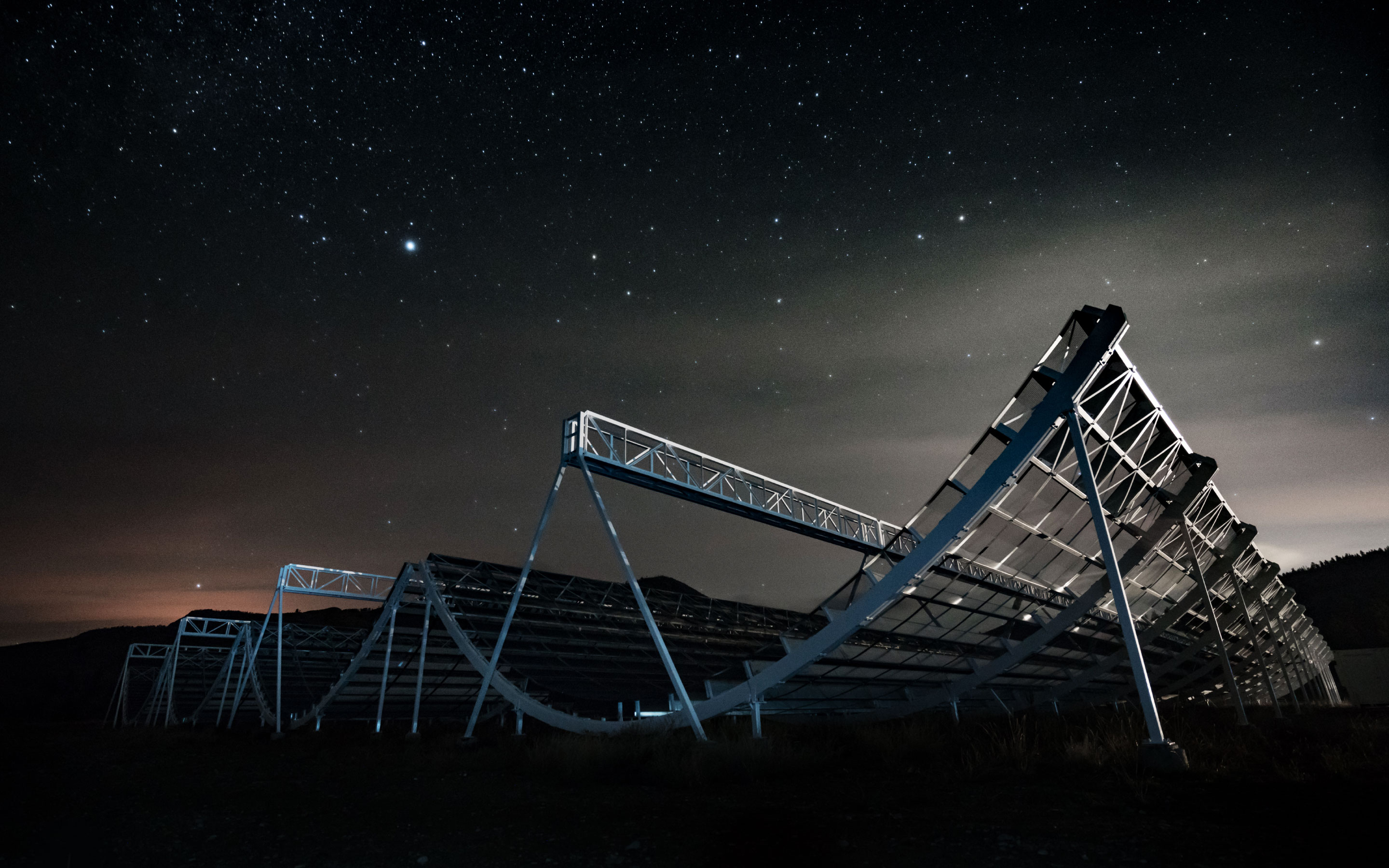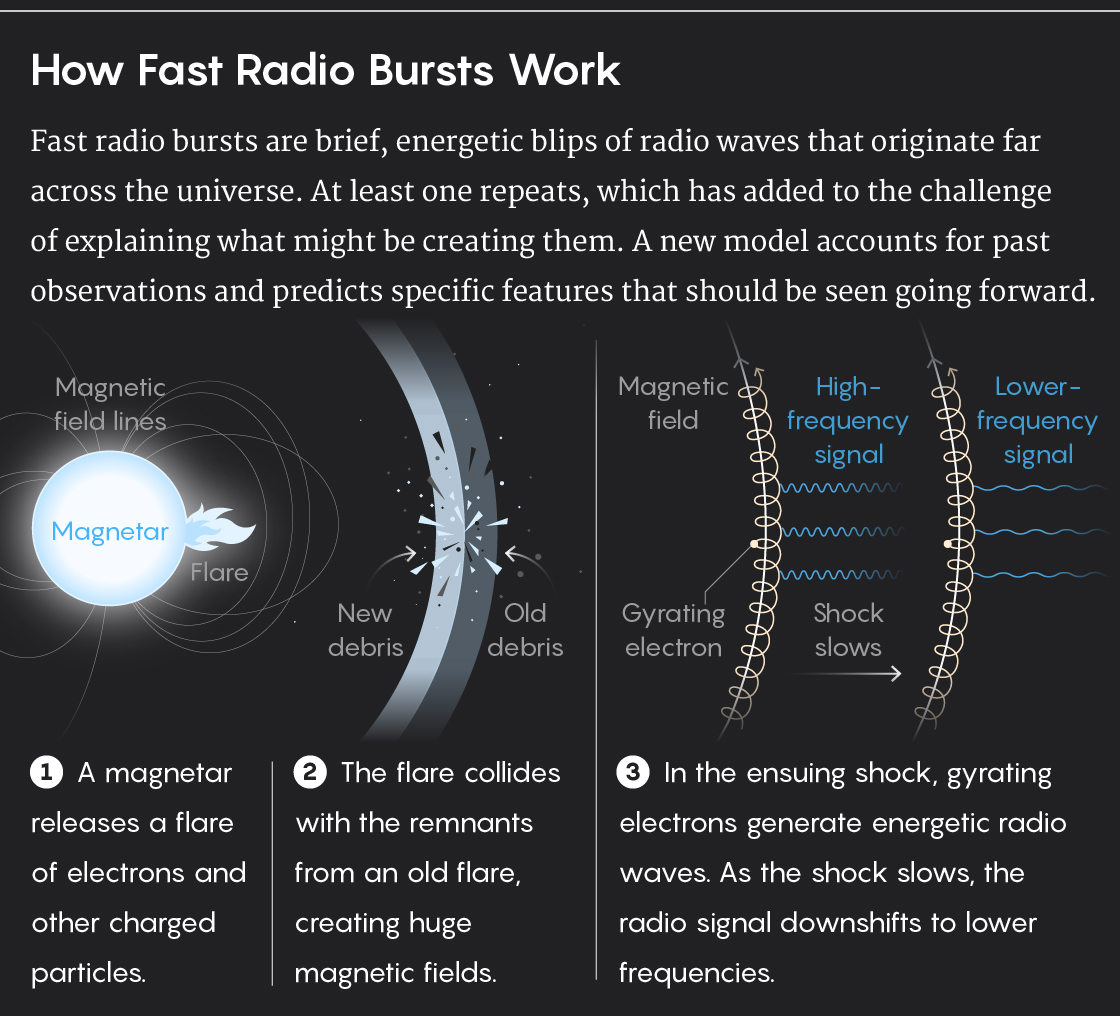With a Second Repeating Radio Burst, Astronomers Close In on an Explanation

The CHIME radio antenna in British Columbia, Canada, is expected to find as many as 10 fast radio bursts a day.
Andre Renard/Dunlap Institute/CHIME Collaboration
Introduction
Between this past Christmas and New Year’s Day, Brian Metzger realized he had his home to himself — no emails coming in, no classes to teach — and maybe, just maybe, the glimmer of an answer to one of astronomy’s most stubborn mysteries.
He chased hard after the lead, worried a little error could unravel everything or that someone else would put together the same pieces first. “You’re racing a little bit against the clock, because other people probably see this as well,” said Metzger, an astrophysicist at Columbia University. “It can kind of become all-consuming.”
Along with scores of other researchers around the world, Metzger has spent the last few years brainstorming ways to understand fast radio bursts (FRBs). These are millisecond-long blips of intense and unexplained radio signals that pop up all over the sky, temporarily outshining radio pulsars in our galaxy despite being perhaps a million times farther away. Before 2013, many astrophysicists doubted that they even existed. In the years since, researchers have invented dozens of possible explanations for what might be causing them. One catalog counts 48 separate theories, a tally that until recently outnumbered the events themselves.
An FRB theory needs two parts, roughly akin to a suspect and a weapon in a cosmic game of Clue. The suspect is an astrophysical beast that can unleash vast sums of energy. The weapon is something that will transform that energy into a bright, head-scratchingly unusual radio signal.
Now Metzger and his colleagues think they have reconstructed the crime scene. Earlier this month they released a paper on the scientific preprint site arxiv.org that sketched out a way for FRBs to arise from explosions in regions of space cluttered with dense clouds of particles and magnetic fields.
The model favors, but doesn’t require, a magnetar as the source of the explosions. A magnetar is a young neutron star that sometimes burps out charged particles in a supersize version of the coronal mass ejections that erupt on the sun. Each new blast plows into the surrounding clutter. When it does, it creates a shock wave, which in turn beams a short, laserlike flash of radio waves halfway across the universe.
“In just very general terms, this makes a ton of sense,” said James Cordes, an astrophysicist at Cornell University, adding that while further details still need to be worked out, “I would say it’s a good horse to bet on.”
What the astronomers really like, though, is that Metzger’s theory generates very specific predictions for what future FRBs should look like, predictions that will soon be put to make-or-break tests. A new Canadian radio telescope called CHIME is expected to find between one and 10 FRBs each day after it becomes fully operational later this year. During initial testing last summer it detected a baker’s dozen of the bursts, results that were published in January. “I think that over the next year or so we’ll be able to test this very well,” said Shriharsh Tendulkar, an astrophysicist at McGill University and a member of CHIME’s FRB team.
At Shock Wave Speed
The theory developed by Metzger and his colleagues Ben Margalit and Lorenzo Sironi builds on the biggest break in the FRB case so far. In 2016, a team led by Laura Spitler at the Max Planck Institute for Radio Astronomy in Bonn, Germany, published their results on the first-ever FRB known to repeat. Previously, each event had been a one-off. As a consequence, astronomers were unable to track down where they were in the sky, so while they suspected FRBs came from far beyond our galaxy, they knew nothing about where. But this one blared out burst after enigmatic burst at unpredictable intervals.
Radio astronomers soon pinpointed its origin to a small, misshapen dwarf galaxy. Trying to squeeze out every clue from these radio signals, they found that it came from a dense region of plasma gripped by extreme magnetic fields. They also found that the burst was surrounded by a fainter, constant radio glow. And last November, the astronomer Jason Hessels (with Spitler and others) noticed something else strange: Each split-second burst actually contains a few sub-bursts that, without fail, shift downward from higher to lower radio frequencies.
To Metzger’s team, this last clue seemed oddly familiar. In the 1950s, physicists studied the blast waves of nuclear weapons to estimate their yields. In these models, the shock fronts from nuclear explosions sweep up more gas as they expand outward. That extra weight slows down the shock, and because it slows, radiation released from the shock front shifts downward in frequency thanks to the Doppler effect.
Metzger had been thinking this blast wave effect might hint at the true nature of FRBs when suddenly, in early January, the haul from the CHIME telescope included another repeating event. This one’s repeating radio signals showed the same downward frequency drift. “The idea was there with the first repeater,” Metzger said, “but seeing that feature of FRBs reinforced sort of put me on overdrive.”
Now Metzger, Margalit and Sironi have released their full model, based mostly on explaining the ins and outs of the first repeater. Imagine a magnetar, a city-sized neutron star forged in a supernova only a few years or decades earlier, its surface roiling and churning. Like the sun on a bad day, this young magnetar releases occasional flares that blast out electrons, positrons and maybe heavier ions at near the speed of light.
When this material launches, it runs into older particles vomited out during previous flares. Where the new ejecta meets the older debris, it piles up into a shock, inside which magnetic fields soar. As the shock presses outward, the electrons inside gyrate around along magnetic field lines, and that motion produces a burst of radio waves. That signal then shifts from higher to lower frequencies as the shock slows. (And presumably, far away and eons later, Earth’s astronomers get a very exciting email alert from radio telescopes.)

Lucy Reading-Ikkanda/Quanta Magazine
All this is still tenuous, but the idea is ready to pass or flunk based on what happens next in the FRB story. It’s the most quantitative, deeply thought-out scenario yet. “They’ve done the most-detailed calculations, and they’ve been able to make the most-specific observational predictions,” Spitler said.
Metzger’s model predicts a number of specific features that future FRBs should share. For one: All future FRBs should follow the same downward shift in frequency. They might show gamma-ray or X-ray emission, which astronomers such as Spitler have already started to hunt for. They should live in galaxies that are forming lots of new stars and producing fresh magnetars. And when they do repeat, they should take breaks from bursting after astronomers observe a major flare. At that point, the system is so choked with material that subsequent flashes can’t make it out.
Metzger’s model now faces a crowded bracket of other, still-viable theories. FRBs could be a consequence of merging neutron stars, which lit up both telescopes and gravitational-wave detectors for the first time in 2017. Neutron stars might also make FRBs when they crash into other objects like black holes or white dwarfs, when they themselves collapse into black holes, or when their magnetic field lines are plucked by fierce winds of plasma.
And it’s not even clear if FRBs all come from a single kind of event. While Metzger’s model has a “stranglehold” on observations of the first repeater, said the astrophysicist Victoria Kaspi, also at McGill, “I personally am always a little nervous when something is so tailored to one source.” Compared with the repeaters, perhaps one-off bursts come from entirely different sources. Or, as Spitler and others pointed out last November, all FRBs might turn out to repeat if astronomers only waited around for long enough.
The data are about to pour in, ready to narrow the field. During the past five months, while CHIME has been in a commissioning phase, researchers have found more bursts that they haven’t publicly released. Team members hope to start the official observing run in April. The Australian Square Kilometer Array, a network of 36 radio dishes in western Australia, is also trawling for more examples and working to pinpoint their exact homes. And within a few years, so will HIRAX: an array of dishes in South Africa, Botswana and Rwanda that will hunt FRBs in an environment free from ambient radio signals.
After years of sparse data and theoretical daydreaming, a solution finally seems within reach. In mid-February, FRB-curious astronomers met in Amsterdam to share new, please-don’t-post-this-on-Twitter discoveries and discuss the idea that neutron stars are in some way responsible. “That is what is so nice about his theory coming out just recently,” wrote Amanda Weltman, a theoretical astrophysicist at the University of Cape Town, in an email. “It is a perfect time.” The researchers debated Metzger’s model, presented at the meeting by his coauthor Margalit, but wouldn’t yet commit to it. “We are on the verge of convergence,” Tendulkar said. “Let’s just put it that way.”
This article was reprinted on Wired.com.



